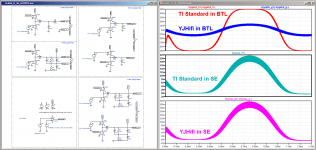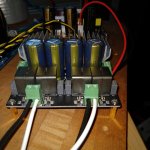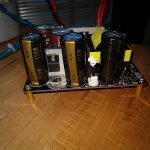So this is a "save on caps" cirquit? Is it really worth the hassle with all these parts? Anyway, even if it works fine, the amp does not sound good. Maybe they should have designed the Bluetooth side better instead of going fancy with parts cost saving mod´s?
@RuslanK35,
no joke, it should work like it is intended by YJ. If the sound is worse with the original YJ arrangement compared to the now TI standard arrangement something's screwed up with the layout.
(I did simulated the arrangement with Spice to understand and asked some guys who should know better than me) 🙂
no joke, it should work like it is intended by YJ. If the sound is worse with the original YJ arrangement compared to the now TI standard arrangement something's screwed up with the layout.
(I did simulated the arrangement with Spice to understand and asked some guys who should know better than me) 🙂
I do not know how it will work, but everything is done differently with them in the TI documentation. I will go mad before I get at least something worthwhile from him. I wanted to deal with the noises in Twitter that remained. I go according to the entrance scheme. I do not understand why there is not a capacitor for 10uF before entering the a b c d channel. Before the entrance there is a resistor at 100 and there is no capacitor. I hate Chinese crafts! while searching for information, 2 thoughts appeared in the noise fields. I found it with a similar problem, but on the TPA3116 board. if interesting link will leave. and the second reason is freq_adj pin. (described in paragraph 2.2 of the document TPA3255EVM user manual). but while the head is no longer working, I'll go to sleep)

YouTube

YouTube
@RuslanK35,
no joke, it should work like it is intended by YJ. If the sound is worse with the original YJ arrangement compared to the now TI standard arrangement something's screwed up with the layout.
(I did simulated the arrangement with Spice to understand and asked some guys who should know better than me) 🙂
hmm.. 😕
but what about these 2x 470µ caps - 1 to gnd the other to PVDD instead of the signal GND as TI
post #850
@RuslanK35
You wont need 10uF for the tweeter channels as they normally don't run fullrange. The input impendance forms a highpass with the DC-linking caps. (Aren't these two black market blue foil caps the DC-linking-caps for the tweeters? Connected via 100R)
Things you may check out of curiosity -> desolder the two foil caps and solder 100nF ceramic in place to compare the noise signature)
That is what i mean, it can be done like that and it should work fine. (Haven't seen such an arrangement in an amp like this before for SE outputs, but makes sense)
You wont need 10uF for the tweeter channels as they normally don't run fullrange. The input impendance forms a highpass with the DC-linking caps. (Aren't these two black market blue foil caps the DC-linking-caps for the tweeters? Connected via 100R)
Things you may check out of curiosity -> desolder the two foil caps and solder 100nF ceramic in place to compare the noise signature)
hmm.. 😕
but what about these 2x 470µ caps - 1 to gnd the other to PVDD instead of the signal GND as TI
post #850
That is what i mean, it can be done like that and it should work fine. (Haven't seen such an arrangement in an amp like this before for SE outputs, but makes sense)
Last edited:
ok Doc...you are an expert and if you say it should work its fine for me...😉
2 things i dont get in my head:
1
if one of these 470µ caps of the PVVD is damaged i drectly get PVDD at the speakers?!
2
the Dc voltage divider 100k /10k is for what???
sorry to bother you
chris

2 things i dont get in my head:
1
if one of these 470µ caps of the PVVD is damaged i drectly get PVDD at the speakers?!
2
the Dc voltage divider 100k /10k is for what???
sorry to bother you
chris
1. As long as the output stage is switching, this shouldn't be an issue.
2. I don't know, maybe intented for bleeding current
2. I don't know, maybe intented for bleeding current
Last edited:
Just a heads up for a new TPA3255 reference design by JPS64 and myself here:
TPA3255 Reference Design Class D Amp GB
TPA3255 Reference Design Class D Amp GB
Hi All I am happy to find this thread re TPA3255 generally with positive comments
I look forward to receiving this amp that i ve ordered from Yuan Jing.
May need 2 to drive semi actively driven speakers I built. But will try out 1 first
I want to move away from hot high energy consuming poweramps
2 way electronic XO
Low pass - to Scanspeak woofers 30W/4558T00 (4ohm,Sensitivity (2.83V/1m) 89 dB)
High Pass - to more efficient tweeter n midrange , 8 ohms each and higher efficiency (via a simple 2 way passive XO).
I will be using a MW 48V 600W 12.5amp PSU.
Will try for High Pass and later Low Pass duties and if OK might get another TPA3255
I look forward to receiving this amp that i ve ordered from Yuan Jing.
May need 2 to drive semi actively driven speakers I built. But will try out 1 first
I want to move away from hot high energy consuming poweramps
2 way electronic XO
Low pass - to Scanspeak woofers 30W/4558T00 (4ohm,Sensitivity (2.83V/1m) 89 dB)
High Pass - to more efficient tweeter n midrange , 8 ohms each and higher efficiency (via a simple 2 way passive XO).
I will be using a MW 48V 600W 12.5amp PSU.
Will try for High Pass and later Low Pass duties and if OK might get another TPA3255
3e Audio tpa3255 amp mod
I came upon the thread after talking to a friend (an EE) who said I should look into the cheap Class D amps from China which sound amazingly good for their price. I’ve been building numerous Gainclone either based on the LM3875 or the LM3886 but have been disappointed with the lower frequency responses (even though the soundstage is pretty amazing when they are designed & built right). I’m using Genesis Physics model 210 speaker (8 ohm), an Akitika PR-101 preamp (bypassing tone controls) and a Cambridge Audio Dacmagic 100 modified as per this posting (Cambridge Audio DacMagic 100 – Audio Purist). So I bought the tpa3255 board from 3e Audio (260watt 2ch amp) along with the ICE2QS03G PS. They were so cheap what could I lose? I connected them all up (using the lightbulb protection startup routine). Everything sounded pretty good on the test speakers and not too bad on my normal stereo system. But there was no presence. It was a perfectly acceptable reproduction of the music (for the money I spent I had little complaints) but the musical reproduction was rather unexciting. I had some audio-grade caps left over from various Gainclone builds so I decided to experiment. I replaced the four cheap 1000uF/63V Chengx caps on the amp board with Panasonic FC grade 1500uF 50V caps. It was an immediate, dramatic improvement in the warmth and soundstage. Then I replaced the three (tiny) 1000uF 50V output caps on the PS with Nichicon MUSE 1000uF 50v caps. Holy cow! This amp sounds fantastic now! I would have skipped all the other Gainclone builds I’ve done (well not really..it’s was fun to build and experiment with them all & I learned a lot along the way). I just can’t believe how good this inexpensive Class D amp sounds now. Nuthin’ wrong with this TPS3255
I came upon the thread after talking to a friend (an EE) who said I should look into the cheap Class D amps from China which sound amazingly good for their price. I’ve been building numerous Gainclone either based on the LM3875 or the LM3886 but have been disappointed with the lower frequency responses (even though the soundstage is pretty amazing when they are designed & built right). I’m using Genesis Physics model 210 speaker (8 ohm), an Akitika PR-101 preamp (bypassing tone controls) and a Cambridge Audio Dacmagic 100 modified as per this posting (Cambridge Audio DacMagic 100 – Audio Purist). So I bought the tpa3255 board from 3e Audio (260watt 2ch amp) along with the ICE2QS03G PS. They were so cheap what could I lose? I connected them all up (using the lightbulb protection startup routine). Everything sounded pretty good on the test speakers and not too bad on my normal stereo system. But there was no presence. It was a perfectly acceptable reproduction of the music (for the money I spent I had little complaints) but the musical reproduction was rather unexciting. I had some audio-grade caps left over from various Gainclone builds so I decided to experiment. I replaced the four cheap 1000uF/63V Chengx caps on the amp board with Panasonic FC grade 1500uF 50V caps. It was an immediate, dramatic improvement in the warmth and soundstage. Then I replaced the three (tiny) 1000uF 50V output caps on the PS with Nichicon MUSE 1000uF 50v caps. Holy cow! This amp sounds fantastic now! I would have skipped all the other Gainclone builds I’ve done (well not really..it’s was fun to build and experiment with them all & I learned a lot along the way). I just can’t believe how good this inexpensive Class D amp sounds now. Nuthin’ wrong with this TPS3255
I have a 3255 evaluation board, which is a wonderful class-D amplifier.
I did a comparison with a Jean Hiraga Class A 30W amplifier, and I found that the class A was very smooth and easy-flowing with the music, though the frequency response was similar. On the vocals, there was a marked difference, the JH producing open and realistic sounding vocals as compared to the 3255.
I did a comparison with a Jean Hiraga Class A 30W amplifier, and I found that the class A was very smooth and easy-flowing with the music, though the frequency response was similar. On the vocals, there was a marked difference, the JH producing open and realistic sounding vocals as compared to the 3255.
Hi turion64
you wrote
Then I replaced the three (tiny) 1000uF 50V output caps on the PS with Nichicon MUSE 1000uF 50v caps.
you change at the power supply or at the amp board at the supply section? pic please ...
chris
you wrote
Then I replaced the three (tiny) 1000uF 50V output caps on the PS with Nichicon MUSE 1000uF 50v caps.
you change at the power supply or at the amp board at the supply section? pic please ...
chris
May i ask why this is called "reference design"?
Really good point!
Class D does not differ from AB or A, if the power supply is dirty, weak or slow, you hear it in the sound quality.
IMO this is also a main reason for different sounding DAC´s , CD-players and relatives.
Products with few, large (fake) electrolytics may profit more from a change than those with many small, no name (non audiophile) capacitors.
I think most important are the capacitors nearest to the switching transistor, so in most cases close to the D-amp chip.
I trust the producers of universal, not special "Audio" SMPS more to use decent parts, then the amp makers that in most cases put fake "audio grade" parts on their boards.
PS I would love to hear more about the "reference design"!
IMO this is also a main reason for different sounding DAC´s , CD-players and relatives.
Products with few, large (fake) electrolytics may profit more from a change than those with many small, no name (non audiophile) capacitors.
I think most important are the capacitors nearest to the switching transistor, so in most cases close to the D-amp chip.
I trust the producers of universal, not special "Audio" SMPS more to use decent parts, then the amp makers that in most cases put fake "audio grade" parts on their boards.
PS I would love to hear more about the "reference design"!
Class D does not differ from AB or A, if the power supply is dirty, weak or slow, you hear it in the sound quality.
The difference is the classD chips (and chip sets like IRS2092) have a signal level power supply (usually lower voltage) as well as a power stage supply. In my experience the signal level power supply is the one to work on first, it has the most impact on perceived SQ.
- Home
- Amplifiers
- Class D
- What is wrong with TPA3255?


